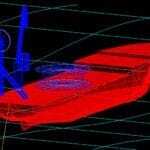Any structures that operate in a marine environment, including offshore drilling rigs, risers, mooring systems, marine vessels, wave power systems, and offshore wind generator facilities, provide unique design and operational challenges that often require significant resources and ingenuity to overcome. Many companies rely on the extensive knowledge and experience of marine consultants to help provide critical analysis of these problems and devise piratical, cost-efficient solutions.

Specializing in marine and offshore structures, fluid dynamics and related disciplines, here are just a few of the services that our marine consultants at Stewart Technology Associates can provide:
1) Hydrodynamic Analysis
Hydrodynamic analysis is used to accurately simulate the forces at work on a structure in a marine environment. This includes the movement of the waves, the action of the tides, the effects of undersea pressures, turbulence from structures or seafloor features, and the effect of high winds and inclement weather. By learning how these forces affect a structure, its design can be improved to eliminate possible failure points and to reduce costs and maintenance requirements. Hydrodynamic analysis can be used to examine both new and existing designs, and it can also be used after a maritime accident to help determine the cause of the problem.
2) Finite Element Analysis
Finite element analysis can be used to model how real-world conditions will affect the operation of a product or of a component of a larger system when subjected to forces such as vibration, heat, high pressures, fluid flow or other physical challenges. The results of the modeling can be used to improve the product’s design, reducing component failures and wear that can shorten its lifespan or lead to increased maintenance costs. Finite element analysis can also make a product safer, and help to determine the cause of failure in an existing design.
3) Structural Design and Analysis
STA can help design and analyze marine structures, such as drilling rigs, jack-ups and liftboats, to make sure that they will perform efficiently and safely in a specified environment. They can work directly with a client to create a structure that will withstand the forces in a particular marine or sub-sea environment safely, while increasing productivity and reducing long-term costs. They can also analyze existing designs to improve their structural performance, productivity and safety.
4) Riser Design and Analysis
Risers are one of the most critical components in an offshore oil drilling or production platform. They carry mud and drilling fluids to the well during drilling operations and carry oil and gas to the surface during production operations. To operate safely while maximizing production, they must be able to withstand the movement and pressure below the surface, while moving fluids efficiently. Engineer consultants can be used to design an efficient riser system for production or drilling operations, determining what type of riser will be needed, rigid, flexible or hybrid, effective mooring solutions, what equipment will be required and other factors. They can also improve the efficiency of fluid moment withing the riser, increasing production, and analyze existing designs to suggest structural, efficiency and safety improvements.
5) Anchor Performance Analysis
Anchors are critical to securing marine vessels and other structures in place temporarily, permanently or semi-permanently, and if they fail to perform adequately, they can allow vessels to drift off course or to collide with other structures, leading to injuries, property damage, productivity losses or environmental concerns. To perform effectively, the design of an anchor must take into account the weight and movement of the vessel, the surface conditions and the composition of the sea floor. With an anchor analysis, engineer consultants can model the forces at work on the anchor and suggest improvements that will make it stronger, safer and more effective.
6) Mooring Design and Analysis
Mooring systems in the offshore oil industry are critical to keep the platform in place during operation, to secure tankers while transferring oil and gas and to secure other vessels as needed. They must be able to withstand the weight of the vessel or platform, while compensating for motion at the surface of the sea and keeping transfer pipes and equipment safe. Engineering consultants can analyze the design of a mooring system, including the anchors, mooring lines and surface structure, ensuring that it can perform both safely and effectively. They can also create new designs for specific applications and analyze the performance of transfer systems.
7) Oil Spill Clean-Up and Containment
Oil spills can have far-reaching consequences, from polluting the water supply and harming animal and plant life, to making beaches less inviting and hurting economies that depend on fishing or tourism. When the worst does happen, the key to minimizing the damage is to contain the oil as close as possible to the source and to clean it up as quickly as possible. Engineering consultants can help to design effective measures for both containing the oil and cleaning it up, including effective boom systems to contain the oil and techniques that can adequately model the currents and conditions at the site to make clean-up more successful and efficient.
8) Forensic Analysis
After a maritime accident or an oil spill, the original cause of the accident can be difficult to determine and, often, there are many contributing factors that make the origin even less clear. Engineer consultants can use hydrodynamic analysis, finite element analysis and other techniques, along with advanced software and extensive knowledge of marine systems, to analyze the events leading up to the accident, as well as the accident itself and its effects, to help determine the original cause. This information can be used to determine liabilities in the aftermath of the accident, to improve designs to prevent future accidents and to establish new safety protocols and programs that can help avoid or mitigate such incidents in the future.
Sources:
https://stewart-usa.com/overview.php
http://usa.oceana.org/sites/default/files/tourism_impacts_fact_sheet_9-8-15.pdf


